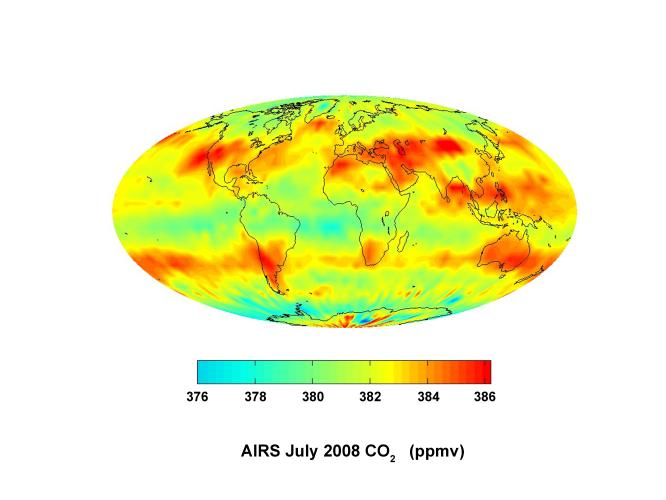[Fact-free speculation on anthropogenic forcing from land use changes.]
Greenhouse gasses not only have an effect much larger than land use changes, but land use changes averaged over all latitudes tend to promote cooling. You seem to equate your clutching at straws for a way to continue your denial of the impact of CO₂ with scientific research, and thus equating uninformed instant speculation with the decades of work of thousands of scientists.
8.3.5 Land Surface Changes
8.3.5.1 Introduction
Anthropogenic land cover change has a direct impact on the Earth radiation budget through a change in the surface albedo. It also impacts the climate through modifications in the surface roughness, latent heat flux and river runoff. In addition, human activity may change the water cycle through irrigation and power plant cooling, and also generate direct input of heat to the atmosphere by consuming energy.
...
8.3.5.3 Surface Albedo and Radiative Forcing
Surface albedo is the ratio between reflected and incident solar flux at the surface. It varies with the surface cover. Most forests are darker (i.e., lower albedo) than grasses and croplands, which are darker than barren land and desert. As a consequence, deforestation tends to increase the Earth albedo (negative RF [Radiative Forcing]) while cultivation of some bright surfaces may have the opposite effect. Deforestation also leads to a large increase in surface albedo in case of snow cover as low vegetation accumulates continuous snow cover more readily in early winter allowing it to persist longer in spring. This causes average winter albedo in deforested areas to be generally much higher than that of a tree-covered landscape (Bernier et al., 2011).
...
8.3.5.4 Other Impacts of Land Cover Change on the Earth’s Albedo
...
Urban areas have an albedo that is 0.01 to 0.02 smaller than adjacent croplands (Jin et al., 2005). There is the potential for a strong increase through white roof coating with the objective of mitigating the heat island effect (Oleson et al., 2010). Although the global scale impact is small, local effects can be very large, as shown by Campra et al. (2008) that reports a regional (260 km²) 0.09 increase in albedo and –20 W m⁻² RF as a consequence of greenhouse horticulture development.
8.3.5.5 Impacts of Surface Change on Climate
...
Numerical climate experiments demonstrate that the impact of land use on climate is much more complex than just the RF. This is due in part to the very heterogeneous nature of land use change (Barnes and Roy, 2008), but mostly due to the impact on the hydrological cycle through evapotranspiration, root depth and cloudiness (van der Molen et al., 2011). As a consequence, the forcing on climate is not purely radiative and the net impact on the surface temperature may be either positive or negative depending on the latitude (Bala et al., 2007). Davin and de Noblet-Ducoudre (2010) analyses the impact on climate of large-scale deforestation; the albedo cooling effect dominates for high latitude whereas reduced evapotranspiration dominates in the tropics. This latitudinal trend is confirmed by observations of the temperature difference between open land and nearby forested land (Lee et al., 2011).
...
8.3.5.6 Conclusions
There is still a rather wide range of estimates of the albedo change due to anthropogenic land use change, and its RF. Although most published studies provide an estimate close to –0.2 W m⁻², there is convincing evidence that it may be somewhat weaker as the albedo difference between natural and anthropogenic land cover may have been overestimated. In addition, non-radiative impact of land use have a similar magnitude, and may be of opposite sign, as the albedo effect (though these are not part of RF). A comparison of the impact of land use change according to seven climate models showed a wide range of results (Pitman et al., 2009), partly due to difference in the implementation of land cover change, but mostly due to different assumptions on ecosystem albedo, plant phenology and evapotranspiration. There is no agreement on the sign of the temperature change induced by anthropogenic land use change. It is very likely that land use change led to an increase of the Earth albedo with a RF of –0.15 ± 0.10 W m⁻², but a net cooling of the surface—accounting for processes that are not limited to the albedo—is about as likely as not.
http://www.climatechange2013.org/images/report/WG1AR5_Chapter08_FINAL.pdf
See also table 8.6 and figure 8.15.
Bala, G., K. Caldeira, M. Wickett, T. J. Phillips, D. B. Lobell, C. Delire, and A. Mirin, 2007: Combined climate and carbon-cycle effects of large-scale deforestation.
Proc. Natl. Acad. Sci. U.S.A.,
104, 6550–6555.
Barnes, C. A., and D. P. Roy, 2008: Radiative forcing over the conterminous United States due to contemporary land cover land use albedo change.
Geophys. Res. Lett.,
35, L09706.
Bernier, P. Y., R. L. Desjardins, Y. Karimi-Zindashty, D. Worth, A. Beaudoin, Y. Luo, and S. Wang, 2011: Boreal lichen woodlands: A possible negative feedback to climate change in eastern North America.
Agr. Forest Meteorol.,
151, 521–528.
Campra, P., M. Garcia, Y. Canton, and A. Palacios-Orueta, 2008: Surface temperature cooling trends and negative radiative forcing due to land use change toward greenhouse farming in southeastern Spain.
J. Geophys. Res. Atmos.,
113, D18109.
Davin, E. L., and N. de Noblet-Ducoudre, 2010: Climatic impact of global-scale deforestation: Radiative versus nonradiative orocesses.
J. Clim.,
23, 97–112.
Jin, M. L., R. E. Dickinson, and D. L. Zhang, 2005: The footprint of urban areas on global climate as characterized by MODIS.
J. Clim.,
18, 1551–1565.
Lee, X., et al., 2011: Observed increase in local cooling effect of deforestation at higher latitudes.
Nature,
479, 384–387.
Olsen, S. C., C. A. McLinden, and M. J. Prather, 2001: Stratospheric N2O–NOy system: Testing uncertainties in a three-dimensional framework,
J. Geophys. Res.,
106, 28771.
Pitman, A. J., et al., 2009: Uncertainties in climate responses to past land cover change: First results from the LUCID intercomparison study.
Geophys. Res. Lett.,
36, L14814.
van der Molen, M. K., B. J. J. M. van den Hurk, and W. Hazeleger, 2011: A dampened land use change climate response towards the tropics.
Clim. Dyn.,
37, 2035– 2043.



